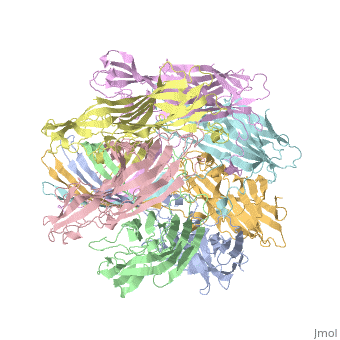Hemolysin
FunctionHemolysin (HL) is exotoxin from bacteria which causes lysis of red blood cells[1]. Hemolysin from the bacterium Clostridium are called alpha-toxin (AT). AT is a zinc metalloenzyme and binds to the membrane in the presence of calcium. It acts as a phospholipase C. See details for α-hemolysin in Pore forming toxin, α-hemolysin. See details of hemolysin E in Molecular Playground/ClyA. For toxins in Proteopdia see Toxins. RelevanceHL acts as a virulence factor in the pathogenesis of invasive infections[2]. |
| ||||||||||
3D Structures of hemolysin3D Structures of hemolysin
Updated on 12-June-2017
A full page in Proteopedia exploring 7ahl is found here.
- β-hemolysin
- γ-hemolysin
- δ-hemolysin
- 2kam – SaHL-δ - NMR
- Hemolysin
- 3o44 – VcHL residues 161-741 – Vibrio cholerae
- 1xez – VcHL (mutant)
- 3a57 – HL 2 – Vibrio parahaemolyticus
- 3hvn – HL (mutant) – Streptococcus suis
- 3fy3, 5keh, 5kf3, 4w8q – PmHL A residues 30-265 – Proteus mirabilis
- 5sz8, 5kkd, 4w8r, 4w8s, 4w8t - PmHL A residues 30-234 (mutant)
- 1mt0 – EcHL B ATP-binding domain – Escherichia coli
- 5c21, 5c22 - EcHL D residues 57-333
- 2wcd – EcHL E residues 2-303 – Escherichia coli
- 1qoy, 4pho, 4phq - EcHL E (mutant)
- 2oai, 2r8d – HL corc_hlyc domain – Xylella fastidiosa
- 2r2z – HL residues 346-435 – Enterococcus faecalis
- 4wx3, 4wx5 - HL – Grimontia hollisae
- 3o44 – VcHL residues 161-741 – Vibrio cholerae
- Alpha-toxin
ReferencesReferences
- ↑ Mestre MB, Fader CM, Sola C, Colombo MI. Alpha-hemolysin is required for the activation of the autophagic pathway in Staphylococcus aureus-infected cells. Autophagy. 2010 Jan;6(1):110-25. PMID:20110774
- ↑ Nizet V. Streptococcal beta-hemolysins: genetics and role in disease pathogenesis. Trends Microbiol. 2002 Dec;10(12):575-80. PMID:12564994
